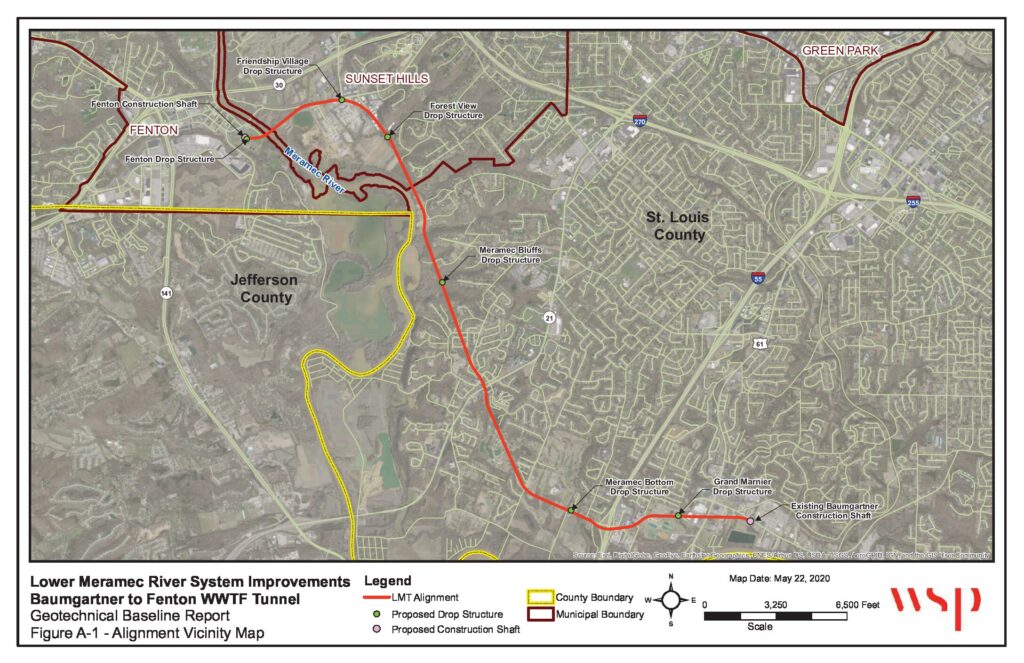Lower Meramec Tunnel Phase 2
As part of a long-term effort to reduce basement backups and sewer overflows, MSD Project Clear is constructing a 6.8 mile-long tunnel approximately 200 feet underground in South St. Louis County. The Lower Meramec Tunnel Phase 2, which runs between Old Towne Fenton and Baumgartner Road, will carry wastewater currently treated at the Fenton Wastewater Treatment Plant to the Lower Meramec Wastewater Treatment Plant allowing MSD to eliminate a flood-prone facility and improving water quality in the Meramec River.
Project Map

Public Meetings
Forest View - March 30, 2021
Friendship Village - March 30, 2021
Meramec Bottoms - May 5, 2021
Grand Marinier - May 5, 2021
Why is MSD constructing this tunnel?
MSD is investing $175 million into the South St. Louis County area with this project to reduce sewer overflows and clean up our local waterways. This section of the tunnel is phase 2 of a two-part wastewater system improvement project to eliminate a flood-prone treatment plant and improve water quality and public health.
The Lower Meramec Tunnel Phase 2 will connect the Fenton Wastewater Treatment Plant to Phase 1 of this project, a deep tunnel that runs from Baumgartner Road and Lemay Ferry to MSD’s Lower Meramec Wastewater Treatment Plant.
When it is finished, the Lower Meramec Tunnel will carry wastewater currently treated at MSD’s Fenton Wastewater Treatment Plant to MSD’s Lower Meramec Wastewater Treatment Plant. This will allow MSD to eliminate the flood-prone Fenton Wastewater Treatment Plant and improve water quality in the Meramec River.
Project Facts:
- Estimated Construction Cost: $175 million
- Anticipated Construction Schedule: 2020 through 2024
- Design Engineers: HDR Engineering, Inc. & WSP USA, Inc.
- Contractor: SAK Construction
- Construction Manager: Black & Veatch
Tunnel Benefits:
- Allows for the elimination of a flood-prone treatment plant (Fenton Wastewater Treatment Plant) and several pump stations
- Improves water quality and public health
- Minimal disturbance to neighboring properties because most of the construction is underground
How will the tunnel be built?
To excavate this tunnel, MSD’s contractor will use a tunnel boring machine (TBM), a machine designed to drill through the rock underground.
The TBM will enter the tunnel through the existing Baumgartner Shaft site near Lemay Ferry and Baumgartner Road. The contractor will also use this shaft to remove the excavated rock material and haul it away.
From there, the TBM will drill an 14-foot diameter tunnel through the limestone at a depth of approximately 150 to 200 feet until it reaches its final destination, the Fenton Wastewater Treatment Plant.
Diversion Structures
This project will include six diversion structures that collect wastewater flows and direct them to the tunnel. While most of the tunnel construction takes place underground and is not visible to the public, construction of the diversion structures occurs near the surface and will be visible.
The six structures are:
- Grand Marnier – 4139 Meramec Bottom Road.
This structure will replace an existing pump station at this site. - Meramec Bottom – 4675 Meramec Bottom Road
A future project will connect a sewer to this structure. - Meramec Bluffs – 10400 Bauer Road
A future project will connect a sewer to this structure. - Forest View – Adjacent to 10911 Gravois Industrial Court
This structure will replace an existing pump station at this site.
- Friendship Village – Gravois Road and Rahning Road
A future project will connect a sewer to this structure. - Fenton – Fenton Wastewater Treatment Plant on Opps Lane
This shaft will be used to retrieve the TBM and will divert wastewater currently treated at the Fenton Wastewater Treatment Plant into the tunnel to be carried to the Lower Meramec Wastewater Treatment Plant.
Blasting
Although most of this project will be constructed using the tunnel boring machine (TBM), the contractor will use blasting to excavate through the rock at the Fenton shaft, to expand the size of the Baumgartner shaft, and to create enough room in the tunnel to install the TBM. Blasting may also be used to excavate the below-ground adits that connect the main tunnel to each of the diversion structures.
- Prior to the initial start of blasting activities, nearby property owners will be offered an inspection of their property, which will document the conditions before any blasting occurs within 500 feet of the property.
- Blasting may occur twice a day during the excavation of the shafts. Each blast takes about eight seconds.
- Before each blast, a blasting signal will be sounded to alert the community that a blast is about to happen.
- The noise and minor vibration from the blasting may be noticeable up to about a half-mile.
- No blasting will occur after 6:30 p.m. or on Sundays.
Documents
Questions?
John Deeken, Construction Manager
Black & Veatch
DeekenJJ@bv.com
636-536-5825
Ray Sherrer, Project Manager
Metropolitan St. Louis Sewer District
rscherrer@stlmsd.com

